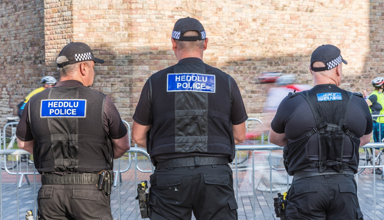A ‘Wales of cohesive communities’ is one of Wales’s seven well-being goals. But the proportion of adults in Wales who agree that there is good community cohesion in their area dropped from 62% in 2013-14 to 52% in 2018-19, and the number of hate crimes recorded by Welsh police forces doubled in the last six years.
Hate crime and community cohesion
Hate crime and hate speech, whether expressed online, in public spaces or in private, is both a cause and result of divisions in communities.
Hate crime is an act of violence, hostility or intimidation directed at someone because of their identity or perceived ‘difference’. It can be related to race or ethnicity, religion, sexual orientation, disability, transgender identity, sex, or age (although the latter two characteristics are not officially recognised as hate crime categories consistently across the UK). It can also be related to more than one of these characteristics.
The All Party Parliamentary Group (APPG) on Hate Crime explored the effect of hate crime and hate speech on individuals and their communities in its recent inquiry (PDF, 3.5MB). It found that communities targeted by hate crime tend to become isolated from the wider community as a direct result of the attacks. Individuals report feeling anger, anxiety and shame, and may change their behaviour by avoiding certain routes, changing their daily commute, or feeling afraid to leave their homes. It can also result in victims retaliating, or wanting to raise awareness in others.
Research by the Equality and Human Rights Commission (PDF, 1.2MB) found that different groups experience hate crime in different ways:
“research suggests that hate crime towards lesbian, gay, bisexual or trans people can involve a greater propensity towards physical violence. Disability hate crime evidence shows high levels of sexual violence and property offences. Certain trigger events (such as global terrorist attacks) have been linked to sharp rises in anti-religious hate crime.”
Measuring hate crime
Hate crime is hard to measure. Surveys do not cover all crimes where hate might be a factor (like homicides or public order offences), and they don’t cover crimes against people aged under 16. But police statistics don’t tell the whole story as many people do not report hate crime to the police.
The number of hate crimes recorded by police forces in Wales doubled between 2012-13 and 2018-19, from 1,765 to 3,932. In 2018-19, the vast majority of these crimes (2,676) were racially motivated, with 751 motivated by sexual orientation, 443 by disability, 206 by religion and 120 by transgender identity.
The Home Office highlights (PDF, 1.4MB) that while increases in hate crime statistics are mainly driven by improvements in crime recording by the police, there were spikes in hate crime following the EU Referendum in 2016 and the terrorist attacks in 2017 (known as ‘trigger events’).
Research (PDF 268KB) by the Centre for Social Investigation echoed this conclusion. But it also found that the proportion of hate crime reported to police has not changed over time, showing that “the increase in racially and religiously motivated hate crime did not reflect a growing tendency for victims to report hate crime”.
The APPG’s research found that hate crime is still largely under-reported for many reasons. These include the fear of not being taken seriously, and the ‘ordinariness’ of hate crime, where its regularity means people don’t identify it as a hate crime.
The impact of online hate speech
The APPG’s research found that online hate speech and attacks can contribute to the normalisation of extremist views, which “emboldens people to abuse and assault people on the street, on public transport, in shops etc.”.
Cardiff University’s HateLab is a global hub for data and insight into hate speech and crime. It uses data science methods, including ethical forms of AI, to measure and counter the problem of hate, both online and offline. It published research (PDF, 1.9MB) in 2019 which found that:
- the reporting, recording and incidence of online hate speech has increased over the past two years;
- an increasingly large number of UK children (aged 12-15) report that they are exposed to hateful content online;
- online hate speech tends to spike for 24-48 hours after key national or international events such as a terror attack, and then rapidly fall, although the baseline of online hate can remain elevated for several months;
- the harms caused by online hate speech to victims and communities are not trivial, often matching those caused by physical crimes;
- where it reaches a certain level, online hate speech can translate into offline hate crime on the streets;
- hate speech often spreads via social media and other ‘intermediary’ platforms, currently largely shielded from legal liability as ‘platforms not publishers’;
- the UK Government is pushing for new and greater internet regulation, and has proposed a new duty of care for tech companies, which is welcomed by the researchers; and
- counter-speech (which is any direct or general response to hate speech that aims to undermine it) is shown to be effective in the right circumstances and if delivered in the right way.
International obligations on racial discrimination
The majority (64%) of hate crimes reported to the police in Wales are racially motivated.
In 2016 the UN Committee’s concluding observations on the UK’s compliance with the International Convention on the Elimination of All Forms of Racial Discrimination (ICERD) raised serious concerns at the culture of racist hate speech and crimes in the UK. It said that “the [2016] referendum campaign was marked by divisive, anti-immigrant and xenophobic rhetoric”, which many politicians “failed to condemn”.
The Committee made a range of recommendations about reducing racist hate crimes in the UK, including legal reform, improving data collection, increasing reporting, and taking measures to tackle racist hate speech online and in public discourse.
The Committee’s concerns were reiterated by the UN Special Rapporteur contemporary forms of racism, racial discrimination, xenophobia and related intolerance in 2019. The UK’s periodic report to the CERD monitoring committee for this reporting cycle is due in April 2020.
The Welsh approach
Some levers of influence related to cohesion and hate crime are not devolved, such as policing, criminal justice, media and internet regulation. But the Welsh Government has taken actions to tackle hate crime and improve community cohesion across all Government departments over a number of years.
The Welsh Government has committed to make ‘a more equal Wales’ of ‘cohesive communities’ in its well-being goals. It also funds Victim Support’s Hate Crime Report and Support Centre, which provides independent advocacy and support for victims of hate crime in Wales.
The Welsh Government announced a range of investment and initiatives in 2019 to tackle hate crime and racism in Wales, including:
- a one-off, £840,000 Hate Crime Minority Communities Grant fund over two years. £360,000 of this fund was provided to the Hate Crime Report and Support Centre to increase capacity. The remaining £480,000 provided support for community organisations working with ethnic minority and faith communities to tackle hate crime, mitigate the impact of Brexit, and provide reassurances following the EU withdrawal;
- £330,00 of funding for a range of organisations across Wales to increase understanding of hate crime and how to report it, challenge negative attitudes in schools and colleges, and explore restorative justice approaches with perpetrators;
- a national campaign to reduce the incidence of hate crimes and incidents in Wales, and
- a commitment to ‘reinvigorate’ the Welsh Government’s commitment to ICERD.
The Government’s strategic approach to hate crime and community cohesion is under review. The draft equality objectives for 2020-2024 include long term aims to eliminate identity-based abuse, harassment, hate-crime and bullying, and the creation of “a Wales of cohesive communities that are resilient, fair and equal”. Specific actions to deliver these objectives will subsequently be set out.
Two Assembly Committees have repeatedly recommended that the Government update its community cohesion delivery plan (PDF, 1.4MB), which it committed to doing twice before (in 2018 (PDF, 301KB) and in 2017 (PDF, 326KB)). In December the Counsel General said the Government was “continuing to consider the most effective and appropriate means of updating our community cohesion plan for the coming years.”
The Welsh Government’s 2014 Hate Crime Framework for Action was followed by a delivery plan in 2016. The most recent progress report was published in 2017, but neither have been updated in recent years.
The Assembly will debate progress on tackling hate crime on Tuesday 3 March, and the new Cross-Party Group on Race Equality, will meet for the first time this week.
Article by Hannah Johnson, Senedd Research, National Assembly for Wales






